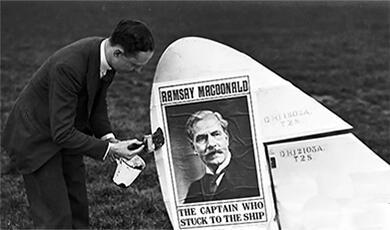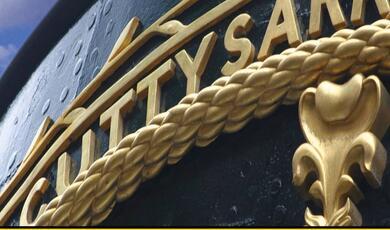Gardening Entrepreneurs
Share
- Details
- Text
- Audio
- Downloads
- Extra Reading
We think of men such as Lancelot "Capability" Brown, (b 1796) as garden and landscape designers, but they were also major contractors and entrepreneurs. Brown, Repton and others in the 18th century were responsible for projects costing - in today's money - billions of pounds.
In the 19th century, Joseph Paxton was not only in charge of huge projects at Chatsworth, he built the Crystal Palace, marketed a range of greenhouses and designed public parks.
The business methods and achievements of these entrepreneurs will be demonstrated as well as their place in British society and their relationships with their clients and employers.
Download Text
21 March 2016
Gardening Entrepreneurs
Professor Sir Roderick Floud
2016 brings the 300th anniversary of the birth of Lancelot "Capability" Brown, the best-known of all Britain's landscape gardeners. The celebrations have already begun and Brown now has his own website.
Brown is justly celebrated; he transformed the English countryside in a way that has endured for over 250 years. His style of gardening has even been claimed to be England's greatest contribution to European culture. But Brown was not only a great designer; he was also a very successful entrepreneur. Today I will concentrate on that aspect of his life and career.
Just as he was one among a large number of garden designers, Brown was also one among many gardening entrepreneurs. We need to assess his achievements by comparing him with others and by exploring the times within which they built their businesses. So I am going to compare and contrast Brown with one of his predecessors, Henry Wise, and one of his successors, Joseph Paxton.
Wise and Paxton are well-known to garden historians, but otherwise less familiar than Brown; so let me begin by a brief sketch of the careers of all three.
Henry Wise was born in 1653; the DNB says that his family came from Oxfordshire, but he was baptised on 4th September 1653 at St. Alfege, Greenwich. Little is known about his early career, but he was certainly apprenticed to, or worked with, George London, gardener first to Henry Compton, Bishop of London, and then to William III and Mary. London was one of the founding partners of what became the great Brompton Park nursery; in 1687 he invited Wise to become a partner. Wise worked with London on the Royal Gardens, beginning in 1691 with the grounds of the Royal Hospital, Chelsea, now the site of that emblem of modern British gardening, the Chelsea Flower Show.
In 1702, on the accession of Queen Anne, Wise became the Royal Gardener. He held that post for the whole of Anne's reign and then also from 1714 to 1727 under George I. In addition to the royal gardens he was responsible, with Vanbrugh, for the enormous garden landscape of Blenheim Palace, as well as for the remodeling of the garden at Melbourne in Derbyshire.
Wise's career as a businessman was centered around Brompton Park. This huge nursery is said to have occupied between 50 and 100 acres of the land now covered by the South Kensington Museums and Imperial College (although this plan of unknown date actually shows an area of about 16.2 acres). In 1702 it was estimated to have nearly 10 million plants for sale.
Many were supplied to the Royal Gardens where Wise held the contract for the maintenance of the gardens; he also separately contracted for huge garden works at Hampton Court and other palaces. In 1709 his success enabled Wise to buy his own estate at The Priory, Warwick.
He retired there in 1727 and created formal gardens on what is now Priory Park, Warwick.
The Priory, originally a Tudor house built on the site of a 12th century priory, was dismantled in the 1920s and re-erected in Richmond, Virginia. Wise died in 1737 and was then said to be worth £200,000, though his biographer prefers the figure of £100,000.
Lancelot Brown was baptised on 30th August, 1716, at Kirkharle in Northumberland. There are various fanciful stories about his birth, but he seems prosaically to have been the fifth child of William Brown, a farmer and land agent to Sir William Loraine. Unusually, the young Brown stayed at school until the age of 16, but then began work as a gardener for Loraine at Kirkharle. We do not know where he was between 1739, when he left Kirkharle, and 1741, but it seems likely that for at least some of this time he was learning hydraulic engineering in Lincolnshire; he certainly met a Lincolnshire girl and married her in 1744. By 1740 or 1741 he was in Oxfordshire and it is said that "the first piece of water he formed was at Lady Mostyn's" at Kiddington, a country house now owned by Jemima Khan. He also worked at Grimsthorpe, where there were extensive waterworks.
It was probably at Kiddington that Brown attracted the attention of Lord Cobham, who was developing his great garden at Stowe in Buckinghamshire. Brown joined him as head gardener in March 1741, at a salary of £25 with £10 for housing and worked with Cobham particularly on the Grecian Valley:
Brown was not actually responsible for very much of the Stowe landscape, but he built his reputation there and then enhanced it by other commissions - such as that at Croome Court, where he built the house as well as the gardens
In 1751 he left Stowe and set himself up as an independent landscape contractor in Hammersmith, the center of the garden trade.
During the next thirty years, Brown became the greatest landscape designer and contractor in England. He is said to have worked for half the House of Lords - although that was a much smaller body than it is in its bloated state today - and he became, after some difficulty, one of the Royal Gardeners under George III. He was not, as is usually said, the Royal Gardener, since there were several others, at least two of them better paid, but he was in charge of Hampton Court and St. James's and also worked at Kew. While living in Wilderness House at Hampton Court, he bought an estate at Fenstanton in Huntingdonshire for £13,000.
He died in 1783; his will contains bequests of £10,000 only, but the value of the residue of his estate is not known. Nor is the value of landed property, which is not included in probate valuations. What can be calculated is the value of his contracts between 1761 and 1783, the staggering sum of £320,000; his own income is likely to have been at least one-fifth of that.
Joseph Paxton, our third example, moves us into the railway age. Paxton was born in Milton Bryan, Bedfordshire (now part of Milton Keynes) in 1803, (baptised 28 Aug 1803), the eighth child of William Paxton, an agricultural labourer. He seems to have started work as a garden boy and was then apprenticed near his home before moving in 1823 to London. His breakthrough - which he achieved partly by lying about his age - was his appointment as a student gardener at the new experimental garden of the Horticultural Society of London in Chiswick; there he met the 6th Duke of Devonshire, the landlord of the garden. All accounts suggest that the Duke was impressed with Paxton's intelligence and good manners, but it was perhaps because the Duke had not taken, until then, much interest in gardening that he took the risk of appointing Paxton as head gardener at Chatsworth. His salary in 1826 was £70 a year.
Chatsworth had been, from the end of the 17th century, one of the great gardens of England, but it was taken to new heights by the 6th Duke, aided and abetted by Paxton. In fact, the 6th Duke became so enthusiastic about gardening and plant collecting that he ran into financial difficulties and Paxton became his chief advisor, rescuing him from near-bankruptcy. The crowning achievement was the Great Stove, an enormous greenhouse, but equally notable were the rock gardens and the Emperor fountain.
It was one of the smaller greenhouses which brought national fame to Paxton, since its design was the basis of the Crystal Palace, scene of the 1851 Great Exhibition of All the Nations. Paxton then capitalised on this success, which also brought him a knighthood, by developing a range of greenhouses for the masses - or at least for the middle classes - while he also designed other gardens and a number of public parks. He became increasingly involved in railway speculation and rich through it - he was particularly keen to develop a railway to bring tourists to Chatsworth; he started The Gardener's Chronicle, and designed great houses such as Mentmore and the Chateau de Ferrières for the Rothschilds.
Paxton organised the Army Works Corps during the Crimean War. He died in 1865, a Liberal MP, leaving about £180,000. Not bad for the 8th child of an agricultural labourer.
How did Wise, Brown and Paxton do it? What were the secrets of their success not only as garden designers but as entrepreneurs? All three came from what used to be called "humble origins" but achieved international fame and also fortune. Before I try to answer these questions, let me anticipate another question - how rich did they become in modern terms?
There are several ways of answering that question and some produce odd results. For example, a recent and otherwise excellent biography of Brown calculates that his salary at Stowe of £25 in 1750 equates to £2,129 today, or way below the modern minimum wage; it is inconceivable that the head gardener of a garden as great as Stowe should have been paid so little. The problem is that the conversion has used the retail price index, which is fine for making short-term comparisons but very misleading over longer periods. A better way is to use an index of Gross Domestic Product per capita, which captures not only price changes but the growth and increasing complexity of our economy. So we can see that Henry Wise was extremely rich, with a fortune of over £300 million in today's terms.
Name
Date
£ at time
£ today
Henry Wise - purchase of Warwick Priory
1709
£10,601-17-0
£32,110,000
Henry Wise (at death)
1737
£100,000
£305 million
Lancelot Brown (salary at Stowe)
1741
£25
£69,580
Lancelot Brown (contracts)
1761-1783
£320,000
£718 million
Lancelot Brown purchase of Fenstanton Estate
1767
£13,000
£29.35 million
Lancelot Brown (bequests at death)
1783
>£10,000
>£19.3 million
Joseph Paxton (salary at Chatsworth)
1826
£70
£100,200
Joseph Paxton (at death)
1865
>£180,000
>£158.2 million
But both Brown and Paxton were very wealthy, particularly as the sums quoted almost certainly exclude the value of their landed property (Paxton was one of about 90 people who died leaving over £100,000 in the year of his death). How did they all make so much money?
To many of their biographers, the answer seems simple. They worked extremely hard - Brown was known for riding 50 or 60 miles a day, as George London, Wise's partner, had done before him - criss-crossing the country and overcoming mud, cold and highwaymen. In addition, it is said they all came from sturdy working-class stock, which appealed to the aristocrats for whom they worked, and who are said to have disdained the middle-class upstart, Humphry Repton, the immediate successor to Brown. Incidentally, Brown himself was probably from what would now be called the middle-classes; he certainly married the daughter of a "very respectable county family". Her father was twice Mayor of Boston.
The truth, as usual, is more complicated. What does an entrepreneur do? In simple terms, he does three things. He sees an opportunity and seizes it to supply something that someone else wants, he organises its production and he finances the project. How did Wise, Brown and Paxton do these three things so successfully?
First, what opportunity did they perceive? They were examples of new men in a new kind of world that was developing in Britain in the eighteenth and nineteenth centuries. For millennia, the economy had been dominated by agriculture, but always with a gradual growth of manufacturing. Manufacturing had already grown so much by 1700 that, at that time, it provided employment for just over a third of workers, while less than half were still employed on the farm. Remember, this is all before what we think of as the cataclysmic change known as the Industrial Revolution.
The changes of the next 200 years were indeed cataclysmic, but in a rather different way from what most of us have been taught. During the 1700s and 1800s, the making of things did become more important, but the really significant changes in employment were the collapse in agriculture and the rise of a new type of occupation; not growing or making things, but providing services, knowledge and expertise. By the end of the nineteenth century, service occupations were as large as manufacturing and much larger than agriculture; today, well over four in five of us work in them. Wise, Brown and Paxton saw an opportunity in this changing economy. They sold not food or manufactured goods, but rather their skills, knowledge and experience. They were not alone - architects, civil engineers, lawyers, bankers, teachers, butlers and head gardeners did much the same. We now call them the professions.
Professionals, like everyone else, need someone to pay them. The genius of our gardening entrepreneurs was that they identified a market for their services and exploited it to their great profit. Who was willing to pay them to create and maintain gardens, on a scale never before seen?
At the end of the seventeenth and throughout the eighteenth century one particularly important paymaster was the British taxpayer. This was not to create public parks or gardens, but to build and maintain the Royal Gardens.
The success of Wise and his partner, George London, together with that of their nursery, Brompton Park, was built on William and Mary's, and Anne's, spending on the Royal Gardens. The money came from the civil list, the costs of the royal household and civil government, and was administered by the Office of Works. In 1702, the Lords of the Treasury - whose leading members would later be called the Prime Minister and the Chancellor of the Exchequer - wrote to the Office of Works to express alarm, not at the King's religion nor at any assertion of royal power, but at how much William was spending on his palaces and gardens - mostly at Hampton Court.
They asked for a return of the expenditure by William and Mary and their two predecessors, Charles II and James II. The answer was staggering. In modern terms, the monarchs had spent about £5 billion in 40 years. Although we don't know exactly how much of this was spent on the gardens, it was probably between £1 billion and £1.25 billion.
No wonder that when Queen Anne came to the throne, she said that she was determined to restrain expenditure, particularly on gardens; however, the allure of garden building and the blandishments of her gardener, Henry Wise, meant that her resolution did not last very long. In fact, when one takes into account the costs of the garden at Blenheim Palace, which was financed by the state as a present to the Duke of Marlborough from a grateful Queen and nation, public expenditure on gardens may well have increased.
Wise received the modern equivalent of £4.7 million each year from the beginning of Anne's reign for the annual maintenance of the royal gardens. This had to cover all the costs of keeping the lawns clipped, the gravel paths raked and weeded and the fruit trees and ornamental shrubs clipped in the fashionable Dutch style. More troublesome, probably, were the fountains, which never worked very well in the flat landscape of the Thames valley. There was also the cost of feeding the wild animals in the menagerie and the cows that provided the butter for the royal slice of bread.
We do not know how much profit Wise made on the contract. However, one of his successors later in the century complained bitterly when he was offered a new contract, which cut severely the profit of 33% which he had been making. So Wise may have been clearing £1.5 million in modern money or more each year. That did not include any payment for new works, which added several million more to his total receipts, particularly as the plants for the new gardens were supplied by his own nursery, Brompton Park. Wise does not seem to have exploited this link: when the suspicious Sir John Vanbrugh checked Wise's prices, he reported that the Queen was not being charged more than any private citizen.
Brown, too, did well from his royal appointment, which may explain why he and his powerful friends lobbied so assiduously for him to get it. Between 1765 and 1783 he was paid £2000 a year, a total of £34,629; in modern money, that is about £75 million. Unlike Wise, Brown does not seem to have been paid for any extra work; he was probably busy elsewhere. At one point, indeed, the Office of Works complained that the Hampton Court gardens were not being properly maintained; Brown responded angrily and the matter was dropped.
Kings and Queens were not the only people spending money on gardening; we know, for example, that Frederick, Prince of Wales, spent £17 million in modern money in two years during the 1730s, creating his fashionable garden at Carlton House. Public expenditure contributed to gardens in other ways; one of Frederick's household, Charles Hamilton, financed his beautiful garden at Painshill from his large stipend as Clerk Comptroller to Frederick and other great garden owners benefitted from positions in various royal households.
Public expenditure thus certainly helped to make Wise and Brown individually rich. The same was also true for Paxton, though in a rather different way. He did not make money directly from his appointment to build the Crystal Palace, since he waived his fee to keep the contract costs down.
However, Prince Albert later gave him £5000, or £5.3 million in modern money, out of the profits of the Great Exhibition. Much less successful was Paxton's involvement with the aftermath, when the building was re-erected in Sydenham, surrounded by the water gardens which Paxton designed and which were intended to emulate those at Versailles.
The result was a public triumph but financial disaster, though not for Paxton but for the shareholders in the Crystal Palace company. However, the Crystal Palace was the springboard for Paxton's business supplying greenhouses for the masses, just as the royal gardens had been for London and Wise for their nursery, Brompton Park.
In this way, public expenditure was the catalyst for private enterprise and private profit. Wise and Brown benefitted from their status as Royal Gardeners and the royal example helped to set the fashions which both men exploited, as Paxton was later to do with his greenhouses.
Like other professionals, the garden designers had to cope with - but also profit from - changing fashions and often capricious clients. Wise operated at the time of the transition from French to Dutch styles and then to the beginnings of the landscape movement which Brown developed so well. Brown captured this style and made it so fashionable that most landowners competed to employ him and then did what he told them; only a few, such as the de Grey family at Wrest Park in Bedfordshire, were able to resist him. There, they insisted on maintaining the old centerpiece of the garden, the rectangular canal, and allowed Brown only to create some of his trademark sinuous lakes around the sides of the garden.
Brown's success with private clients was spectacular. Between 1761 and 1783 he worked for over 125; they included 7 Dukes, 26 Earls, 20 other Peers, 19 Knights or Baronets, 2 Generals and a Judge. They are all listed in his Account Book.
The slide shows the payments made by the Duke of Marlborough for work at Blenheim between 1764 and 1774. Tantalisingly, this single ledger page is the only record that exists of works costing £21,539, or just over £50 million in modern money.
Economists usually assume that tastes are fixed - it makes it much easier for their mathematical models - but anybody dealing with garden history realises that tastes are actually fickle rather than fixed. Gardening is a fashion industry, albeit one in which the fashions literally grow and develop over generations rather than changing, like women's clothes, each year with the seasons. Like haute couture, gardening - at least on the scale practiced by our three men - demands large incomes and large willingness to spend. Wise, Brown, Paxton and their many colleagues had to accommodate themselves to aristocratic fashions, while persuading their clients of their expertise in spending large amounts of their money; Brown got his name "Capability", remember, through his ability quickly to assess the "capabilities" of a site.
Capricious clients could, of course, lead to profit. Everyone knows the dangers of adding new tasks while builders are on site. In 1701 William III did just that, in the Privy Garden at Hampton Court. The King had initially ordered that the southern end of the garden be lowered by 8 ft., so that he could see the river from his first-floor rooms, the piano nobile, in the palace. This was done in the winter of 1700-1701, the Privy Garden was fully planted and statues and fountains were placed in it. Then, in June 1701, William visited his rooms and discovered that he could still not see the Thames. He ordered that the whole garden should be lowered; this meant all the new plants, paths and statues had to be removed and 3 ft. of soil taken from an area of 5 acres. Remarkably, this work - which also involved removing and re-laying the water pipes across the site - was completed by November and all the plants replaced. It had cost £1426-4-4 (£4.1 million) on top of the cost of the original work. William now had his view of the river.
Maintaining good relations with their clients seems to have been one of the secrets of the success of Wise, Brown and Paxton. Queen Anne clearly trusted Henry Wise, since in 1702, after expressing her intention "to restrain the expense of the gardens", she sent for Wise "to know what is due and what expense will be necessary for the future in the Gardens." There is, however, no evidence of a closer relationship of Wise with any of his royal clients, whereas there is ample evidence of Brown's with his; he was almost universally trusted and liked by his employers and patrons, from Lord Cobham onwards. As the Dictionary of National Biography puts it, Brown "had the friendship of a series of Prime Ministers (William Pitt, his rival Lord Bute, George Grenville and Lord North) and the ear of George III. Among his clients only Lord Shelburne at Bowood and Sir John Griffin Griffin at Audley End are known to have objected to him, either as a man or as a designer; both were themselves impossible clients…." This is quite an achievement.
As his son-in-law and collaborator, Henry Holland, put it: "He left [his clients] pleased and they remained so as long as he lived." Lord Coventry of Croome: "held him very high as an artist and esteemed him as a most sincere friend." (Turner 1985:60) Paxton, finally, not only became the closest advisor and confidante of the 6th Duke of Devonshire but also, even allowing for the usual tendency not to speak ill of the dead, seems to have been universally popular among all his other clients.
So our three men were good salesmen and able to spot and capitalise on opportunities in the market. Those are the first requirements of an entrepreneur. But plenty of good salesmen have gone bankrupt or failed to deliver. How did they make sure that their projects were carried out?
Here their strategies seem to have been different. Wise built on the success of his partner and predecessor, George London, in basing his activities on his contract as Royal Gardener.
The contract stretches over several pages of a large ledger in the national archive and specifies, in minute detail, what Wise and his gardeners had to do. At Kensington Palace, for example, one part of the garden had to be: "…… kept in good order by the grass being Rolled Mow'd and Swept, the gravell Rolled & weeded the Borders Dung'd, Dugg, Hoes, Raked & weeded, the Hedge Lynes clipt, the severall hardy evergreens & other plants Staked, tyed up prun'd & Clipt, the Fruit Trees prun'd and nailed, & the severall Collections of House Greens and Flower Roots to be well mannaged & kept in good order." Other parts of the contract specified what tools had to be supplied; it is a list remarkably similar to the contents of a potting shed today: spades, rakes, shears, wheelbarrows, trowels etc. The only unusual item which the contractor had to supply was "a Sort of Engine to Sprinkle ye Trees and Plants".
We do not know how many men Wise employed. Under his predecessor, the Earl of Portland, a total of 72 gardeners was employed at Kensington for only 17 acres, with 40 men and 10 women looking after the "incredibly intricate parterre and wilderness"[1] and 20 men and women in the kitchen garden. At Hampton Court there were 80 gardeners in all, including three head gardeners - one each for the Privy Garden, the Wilderness and the hothouses - with a foreman in charge of grass and gravel. Finally, three important functionaries were; a bowling green keeper, a rolling horse keeper and - a fixture in all great gardens - the mole catcher. Wise may well have economised on some of these, since his price for the work was half that of Portland, but it is likely that most were still required.
Managing and organising such a large labour force cannot have been easy and Wise must have relied on his head gardeners and foremen. It also seems, from the very detailed estimates that he submitted for the many extraordinary works - that is, on top of his regular contract - that he employed sub-contractors for the large earth-moving works that were required. Capability Brown carried this method of working much further.
Although Brown must have employed a labour-force at Hampton Court and St. James's, his two responsibilities as one of the Royal Gardeners, his other projects were organised almost entirely through sub-contractors. His normal method of working was to begin by spending two or three days at a site - assessing its capabilities - and then to commission a survey and plans for the work; he had several surveyors who were semi-permanent employees. After that the client could either employ his own estate staff, in which case Brown would take just a design fee, or he would parcel out the work to sub-contractors - he had favourite men around the country.
These are the men who appear in the ledgers of Brown's accounts with Drummond's Bank; tantalisingly, there is just a series of payments, with no indication of what the payments were for. Presumably, they were mainly to sub-contractors to pay labourers, although some payments have been identified to nurseries.
Sub-contracting was a system widely used in the 17th and 18th centuries. It was used by Wren, for example, in building St. Paul's Cathedral and also in the construction of the first Westminster Bridge, where there were separate contractors for each pier. It became the method of constructing the huge canal network in the second half of the eighteenth century, where different short sections of a canal were dug and the bottom and sides laid by separate gangs of men controlled by the sub-contractor.
The great landscaping works were just as complex. People sometimes think that Brown just dammed convenient streams to create his lakes. Far from it. At Blenheim, Brown's largest lake and more than a mile long, the entire area was lined with layers of clay - later called "puddled clay" - working from the bottom upwards. The lowest layer was the thickest, at 1.2 m, and the clay in the lower layers was mixed with lime to stop animals burrowing through it. Every layer - and there seem to have been eight - was rammed down by gangs of men, each team working with a different type of hammer. Each layer was worked at right angles to the previous one and the last was preceded by a 5 cm layer of chalk. As the layers were laid, the lake was allowed to fill to stop them drying out. The construction of the cascade which conceals the dam at the lower end of the lake was even more complicated, given the weight of water which was held back. It all took four years to complete.
This illustrates the extent to which Brown, and his predecessors such as Wise, were skilled water engineers. Histories of canal-building usually attribute the invention of puddled clay in lining and waterproofing canals to James Brindley; this is nonsense. The garden builders were far ahead of the canal builders.
Paxton, finally, was different again. Much of his career was spent as head gardener to the 6th Duke of Devonshire, but the Duke was happy for him to accept other commissions for both private and public clients - Paxton developed a profitable line in laying out public parks and cemeteries. It was only after the Duke's death that he really developed his own consultancy and architectural business, leading to the building of Mentmore in Buckinghamshire and the Chateau de Ferrières near Paris.
His greenhouses were marketed in yet another way; Paxton patented his method and then licensed it to a manufacturer.
The final aspect of the success of our three men was that they could manage money, the third requirement of an entrepreneur.
The clients paid Wise, Brown, Paxton and their colleagues for their knowledge, their technical expertise and their skills in training and managing a large labour force. The garden entrepreneurs had to justify the trust which their clients clearly placed in them; they also had to keep track of their projects, assistants and sub-contractors, scattered across the country; finally, as well as estimating costs, they had to disburse payments and manage cash flow. In the 1760s, for example, Brown's annual turnover averaged £15,000 - or £36 million in modern money.
Yet there is no evidence that he used any accounting system more complicated than simply recording receipts and payments. His accounts at Drummond's Bank show that, as was customary at the time, business transactions were intermixed with payments to his wife and other household expenses.
This was typical of the accounting system used throughout the country on the great and small estates - their records still survive in county record offices - but it meant that there was no means of estimating the costs of, or returns to, capital expenditure or, indeed, of calculating the costs and income associated with any individual project. Brown may have had some other means of keeping track of jobs, as he was famous for having returned some money to a client when he thought he had been overpaid; but such records have not survived.
Earlier, Wise was certainly capable of estimating the costs of projects, costing millions of pounds in modern terms, down to the nearest farthing, and of defending his estimates from scrutiny by the Office of Works; they normally struck out some costs but left the great majority intact. But it was only well into the nineteenth century that anything that we would recognise as cost or management accounting was developed and applied. The way out of the problem of all the uncertainties which stemmed from this rudimentary accounting was to put in a very high estimate. Therefore successful eighteenth century enterprises have rates of profit which are very high by modern standards. When entrepreneurs got it right, as Wise, Brown and Paxton clearly did, this could make them very rich; others got it wrong. This is shown by the pitiful and occasionally acrimonious correspondence between the widow of Charles Bridgeman, who succeeded Wise as Royal Gardener, with the Office of Works and Sarah, Duchess of Marlborough. Bridgeman is said to have left his family in destitution and his widow pursued for years her claims to payment, with ultimate success.
Brown's accounts are surprising in another way. They show that, at least from 1761, he was able to require payments in advance, presumably because he could by that time pick and choose his clients and impose such a condition on them. This was extremely unusual; the British aristocracy in general had a terrible reputation for failing to pay their bills. There are numerous accounts of small tradesmen being forced into bankruptcy and the debtor's prison because of no or very late payment of their bills by noble families. One of the reasons why Wise's partner, George London, travelled so much was to collect the money due to him and to Brompton Park. But Brown's ability to get payment up-front must have done wonders for his management of cash-flow; he would also have benefitted hugely in this respect - as would Wise also have done - from the regular payments from the royal household. In this way again, to repeat my earlier point, public expenditure was central to the success of Brown and Wise.
Conclusion
Let me sum up. My three subjects, Wise, Brown and Paxton, were exceptional men. They were not only gifted designers, who could both visualise and then carry out complex works over vast areas of land. With little conventional education, they became expert in botany, in architecture and in civil engineering. But they were also successful entrepreneurs, able to spot opportunities in the market and capitalise on them, able to sell their services to demanding clients, able to organise large labour forces and able to manage their money, each becoming very rich.
Moreover, they were entrepreneurs of a new kind. They did not build their reputation and their wealth through agriculture or through the growing manufacturing businesses of the Industrial Revolution; instead, they sold their services to a series of demanding and wealthy clients and not least to the British government. We are constantly told today that public expenditure is a burden on the hardworking taxpayer. But actually there are countless examples, of which gardening is only one, of public spending priming the pump of economic activity or underwriting new industries. The world-wide-web is only the latest demonstration. So, when next you visit St. James's Park, or Kensington Gardens, or Kew, or the municipal parks around Britain which Paxton helped to build, think not only of their beauty but of the way in which they exemplify the creation of a great British industry, that of gardening.
© Professor Sir Roderick Floud, 2016
[1] Jacques and van der Horst 1988:73
Part of:
This event was on Mon, 21 Mar 2016
Support Gresham
Gresham College has offered an outstanding education to the public free of charge for over 400 years. Today, Gresham College plays an important role in fostering a love of learning and a greater understanding of ourselves and the world around us. Your donation will help to widen our reach and to broaden our audience, allowing more people to benefit from a high-quality education from some of the brightest minds.


 Login
Login







